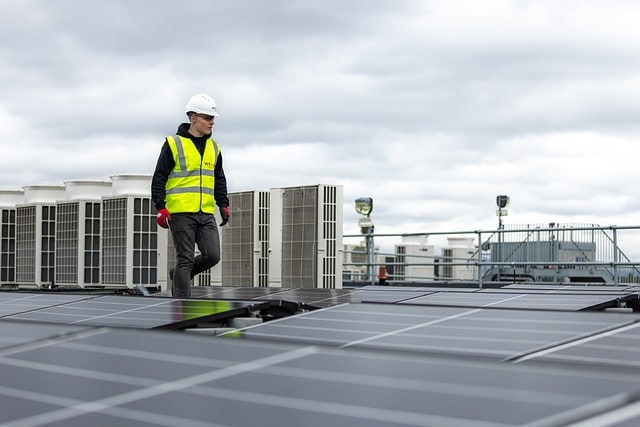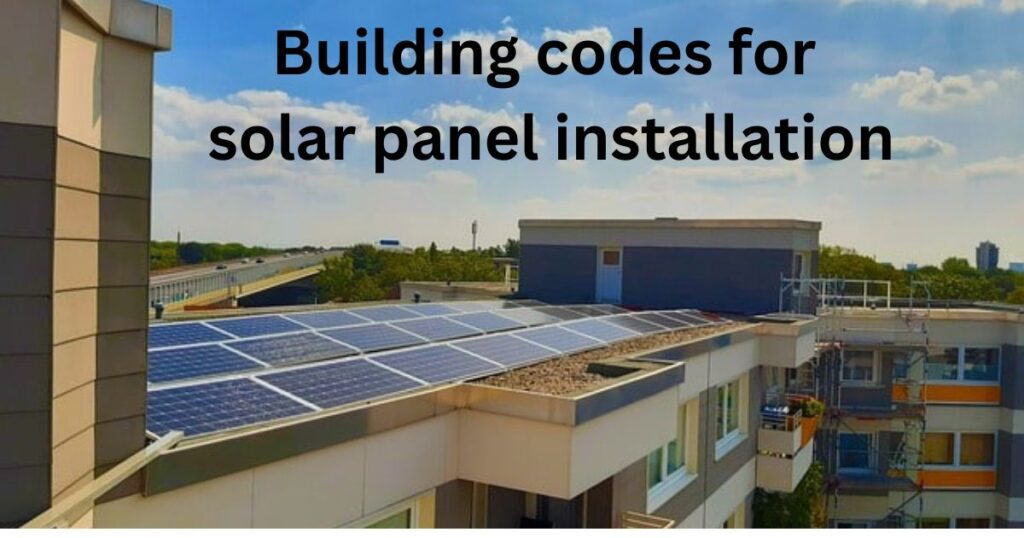Last updated on March 7th, 2025 at 03:54 am
Building codes for solar panel installation are crucial for ensuring the safety, efficiency, and longevity of solar energy systems. These codes, which encompass structural, electrical, fire safety, and zoning regulations, provide a comprehensive framework for the proper design, installation, and maintenance of solar photovoltaic (PV) systems.
By adhering to these guidelines, homeowners, contractors, and developers can ensure that their solar installations not only comply with legal requirements but also optimize performance and safeguard both people and property.
In this article, we’ll dive deep into the ins and outs of building codes for solar panel installation, covering everything from structural integrity and electrical safety to fire prevention and the permitting process. By the end, you’ll have all the knowledge you need to navigate these complexities with confidence, setting you up for a successful and compliant solar project. So, let’s get started on making your solar journey smooth and hassle-free!
1. Adhering to building codes is crucial for the safety of both the installation and the occupants.
2. Obtaining the proper permits, such as building, electrical, and zoning permits, is essential.
3. Assessing the structural integrity of the roof and following proper conduit, wiring, grounding, and bonding practices are critical.
4. Fire codes mandate clearances, access pathways, rooftop disconnects, and proper labeling.

Importance of Understanding Building Codes for Solar Panel Installation
Ensuring Safety and Structural Integrity
One of the primary reasons for adhering to building codes in solar panel installation is to ensure the safety and structural integrity of the building. Building codes are designed to address several critical safety concerns:
Load-Bearing Capacity: Solar panels and their mounting systems add weight to a roof. Building codes stipulate the maximum allowable weight that a roof can support, ensuring that the additional load from the solar panels does not compromise the structural integrity of the building. This includes both the dead load (weight of the panels and mounting equipment) and live load (environmental factors like wind, snow, and maintenance personnel).
Fire Safety: Properly installed solar panels must comply with fire safety codes to prevent potential fire hazards. This includes maintaining adequate clearances, ensuring proper electrical wiring, and installing fire-resistant materials where necessary. Building codes often require specific spacing between panels and other rooftop structures to allow for firebreaks and easy access for firefighting.
Electrical Safety: Solar panel systems involve complex electrical components and wiring. Building codes, particularly the National Electrical Code (NEC), provide detailed requirements for the safe installation of electrical systems. This includes proper grounding, bonding, and the use of appropriate conduit and cable management systems to prevent electrical fires and shocks.
Legal Compliance and Avoiding Penalties
Understanding and adhering to building codes is essential for legal compliance. Failure to comply with these codes can result in several legal and financial consequences:
Fines and Penalties: Non-compliance with building codes can lead to fines and penalties imposed by local authorities. These fines can be substantial and may significantly increase the overall cost of the solar panel installation project.
Insurance Issues: Insurance companies often require proof of compliance with building codes to provide coverage. If an installation does not meet code requirements, insurance claims related to the solar panel system may be denied, leaving the property owner financially responsible for any damages or losses.
Resale Value and Marketability: A property with non-compliant solar panel installations may face challenges in the real estate market. Prospective buyers may be wary of purchasing a property that does not meet building codes, potentially reducing the property’s resale value and marketability.
Facilitating Smooth Installation and Approval Processes
Understanding building codes can significantly streamline the installation and approval process for solar panel systems:
Simplified Permitting Process: Familiarity with building codes helps in preparing accurate and complete permit applications. This can expedite the approval process, as local authorities are more likely to approve applications that demonstrate a clear understanding of and compliance with relevant codes.
Minimizing Delays and Rework: By adhering to building codes from the outset, installers can avoid costly delays and rework caused by non-compliance issues. This ensures that the project stays on schedule and within budget.
Key organizations setting codes for solar panel installation
Solar panel installation codes play a critical role in ensuring the safety, efficiency, and legal compliance . Several key organizations and authorities are responsible for developing and enforcing these codes.
Understanding the roles and contributions of these bodies is essential for anyone involved in the planning, installation, or maintenance of solar energy systems. Here’s a detailed look at the main organizations and codes:
International Building Code (IBC)
The International Building Code (IBC) is one of the most widely adopted and comprehensive building codes in the world. Developed by the International Code Council (ICC), the IBC sets forth minimum requirements to safeguard the health, safety, and general welfare of building occupants.
The IBC’s primary purpose is to ensure that buildings are safe for occupancy by addressing a wide range of safety issues. It includes detailed requirements for structural strength, stability, and durability, ensuring that buildings can withstand the loads and stresses they are subjected to over their lifetime.
This includes provisions for dead loads (permanent fixtures), live loads (occupants and movable objects), and environmental loads (wind, snow, seismic activity). By providing these detailed guidelines, the IBC helps prevent structural failures that could lead to catastrophic events.
For solar panel installations, the IBC is particularly relevant because it ensures that the additional loads imposed by the solar panels and their mounting systems do not compromise the structural integrity of the building.
The code specifies how to assess the roof’s load-bearing capacity to support the weight of the solar panels and the mounting hardware. This is crucial in preventing structural damage or failure, especially in regions prone to heavy snow loads or high wind speeds.
National Fire Protection Association (NFPA)
The National Fire Protection Association (NFPA) is a global nonprofit organization dedicated to eliminating death, injury, property, and economic loss due to fire, electrical, and related hazards.
The NFPA 1, or Fire Code, includes provisions specifically tailored to the installation of solar PV systems. It addresses fire safety concerns by setting requirements for system labeling, access pathways, and clearances around solar arrays.
These guidelines ensure that firefighters can safely access rooftops and other areas where solar panels are installed during an emergency. Proper labeling of PV system components is crucial for informing emergency responders about the presence and layout of solar panels, reducing the risk of electric shock during firefighting operations.
NFPA 70E focuses on electrical safety in the workplace, providing essential guidelines for protecting workers who install and maintain solar PV systems. It includes standards for safe work practices, personal protective equipment (PPE), and procedures for working with energized electrical systems. By following NFPA 70E, solar installers and maintenance personnel can reduce the risk of electrical injuries and ensure safe working conditions.
National Electrical Code (NEC)
The National Electrical Code (NEC), also known as NFPA 70, is a critical standard developed by the National Fire Protection Association (NFPA) to ensure electrical safety in residential, commercial, and industrial buildings.
The NEC is organized into various articles that address different aspects of electrical installations. Each article covers specific topics such as wiring methods, grounding, overcurrent protection, and equipment installation.
One of the key sections relevant to solar photovoltaic (PV) systems is Article 690, which provides detailed requirements for the safe installation of solar PV systems. This article addresses crucial aspects such as system grounding, conductor sizing, overcurrent protection, disconnecting means, and marking and labeling of PV components. By following these guidelines, installers can ensure that solar PV systems are integrated safely into the building’s electrical infrastructure.
Pre-Installation Requirements for Solar Panel Systems
Site Assessment and Feasibility Studies
Before embarking on a solar panel installation, a comprehensive site assessment and feasibility study are crucial to ensure that the proposed location is suitable and that the system will perform optimally.
The first step in a site assessment is evaluating the structural integrity of the roof. This involves a detailed inspection to determine whether the roof can support the additional weight of the solar panels and mounting hardware.
The current state of the roof must be checked for any existing damage or weaknesses that could compromise the installation. It’s advisable to repair or replace an aging roof before installing solar panels to avoid future issues.
Different roofing materials and structures, such as flat roofs, pitched roofs, or those made from metal, asphalt, or tiles, may require specific mounting solutions. Compatibility with these materials ensures a secure installation.
Permits and Documentation
Securing the necessary permits and preparing the required documentation are essential steps to ensure compliance with local regulations and to facilitate a smooth installation process.
The specific permits needed can vary depending on the location and the scope of the installation, but generally include:
- Building Permit: Ensures that the structural aspects of the installation comply with local building codes.
- Electrical Permit: Required for any electrical work involved in the installation, ensuring it meets safety standards.
- Zoning Permit: Ensures that the installation complies with local zoning laws, which may regulate the placement and appearance of solar panels.
- Special Use Permits: In some cases, additional permits may be needed, such as environmental impact permits or historical preservation approvals if the building is in a designated area.
Process of Obtaining Permits
The process for obtaining these permits typically involves several steps:
- Application Submission: The installer or property owner submits detailed applications to the relevant local authorities, including information about the project scope, location, and compliance with local regulations.
- Review and Approval: Local authorities review the application to ensure compliance with building codes, electrical codes, zoning laws, and other relevant regulations. This might include an inspection of the site.
- Inspection: Once the installation is complete, an inspection is usually required to verify that the work complies with the approved plans and all relevant codes and standards. The installation must pass this inspection to receive final approval.
Necessary Documentation
Several key documents must be prepared and submitted as part of the permit application process:
- Blueprints: Detailed plans of the proposed installation, including the layout of the solar panels, electrical wiring diagrams, and mounting system specifications.
- Structural Reports: Engineering reports that verify the roof’s structural integrity and its ability to support the solar panel system.
- Electrical Schematics: Detailed diagrams showing the electrical components of the system, including wiring plans, inverter locations, and connections to the building’s electrical system.
- Manufacturer Specifications: Documentation from the solar panel and inverter manufacturers, including performance specifications, installation guidelines, and safety information.
- Site Plan: A map or diagram showing the property layout, the location of the solar panels, and any relevant features such as existing structures or shading sources.
Electrical Codes and Safety for Solar Panel Installations
Ensuring electrical safety in solar panel installations is paramount, given the complexities and potential hazards involved. Compliance with electrical codes and adherence to best practices helps protect both the installers and end-users. Here’s a detailed look at key components of electrical safety in solar installations:
Wiring and Connections
Proper conduit and cable management are essential for the safety and efficiency of a solar panel system. Electrical conduits protect wires from physical damage, moisture, and UV exposure. The National Electrical Code (NEC) specifies the types and sizes of conduits that can be used for different applications.
For solar installations, both metal and non-metallic conduits are used, depending on the environment and specific requirements of the installation. Cables should be routed in a manner that minimizes exposure to physical damage. This often involves securing them along roof rafters, under eaves, or within walls. Cable trays and supports can be used to maintain orderly and safe routing.
All electrical connections must be secure and protected. This includes using weatherproof junction boxes for outdoor connections and ensuring all connectors are rated for the specific application and environment.
Grounding and Bonding
Grounding and bonding are critical for the safety of electrical systems, preventing electrical shock hazards and ensuring the system operates correctly. Grounding involves connecting the electrical system to the earth, providing a path for fault currents to safely dissipate.
For solar PV systems, this includes grounding the metal parts of the solar array, mounting structures, and inverter. The NEC provides detailed requirements for grounding, specifying the types of conductors and connections to be used.
Bonding ensures that all metal parts within an electrical system are electrically connected, reducing the risk of electrical potential differences that could lead to shock hazards. Proper bonding is crucial for the integrity of the grounding system and overall safety.
Inverter Installation
Inverters are a key component of solar PV systems, converting the direct current (DC) produced by solar panels into alternating current (AC) used by most electrical devices. The placement and ventilation of inverters are crucial for their performance and longevity.
Inverters should be installed in locations that are easily accessible for maintenance but also protected from direct sunlight, moisture, and extreme temperatures. Common locations include garages, basements, or dedicated inverter rooms.
Inverters generate heat during operation and require adequate ventilation to prevent overheating. Installation guidelines often specify minimum clearance around the inverter and ventilation requirements to ensure proper airflow.
Battery Storage Systems
Battery storage systems are increasingly integrated with solar PV systems, providing backup power and enhancing energy management. Integrating battery storage with solar systems must comply with specific codes to ensure safety and functionality.
The NEC includes provisions for energy storage systems (ESS) under Article 706. These requirements cover the installation, grounding, and protection of batteries, ensuring safe integration with solar PV systems.
Local utility and regulatory requirements for interconnecting battery systems with the grid must be followed. This includes compliance with standards for anti-islanding, which prevents batteries from feeding power into the grid during outages.
Fire Safety and Emergency Response in Solar Panel Installations
Fire safety is a critical aspect of solar panel installations, ensuring that systems are safe for both occupants and emergency responders. Compliance with fire codes and effective coordination with local fire departments can significantly reduce risks associated with solar PV systems. Here’s a detailed look at fire safety and emergency response considerations:
Fire Code Compliance
Adhering to fire codes is essential to ensure the safety of solar panel installations. Fire codes provide guidelines for clearances, access pathways, and other safety measures to facilitate effective emergency response.
Fire codes often require specific clearances around solar panels to ensure access for firefighting operations. These clearances can include minimum distances between the edge of the roof and the solar panels, as well as spacing between rows of panels. These gaps allow firefighters to navigate the roof safely and provide space for ventilating the building if needed.
Access pathways are essential for safe and efficient movement across the roof. Fire codes typically mandate pathways along the roof edges, between solar panel arrays, and around equipment such as HVAC units. These pathways must be free of obstructions to enable quick and safe access during an emergency.
Rooftop Disconnects and Labeling
Rooftop disconnects and proper labeling of solar installations are critical for the safety of emergency responders. Disconnect switches allow firefighters to quickly and safely shut down the solar PV system during an emergency.
These switches should be easily accessible and clearly marked. The NEC and fire codes provide specific requirements for the placement and functionality of these disconnects. Proper labeling of all system components is essential to inform emergency responders about the presence of solar PV systems and their specific configurations.
Labels should include information about the location of disconnect switches, the layout of the solar array, and the type of electrical equipment used. Clear and durable labeling helps prevent confusion and enhances safety during firefighting operations.
Coordination with Local Fire Departments
Effective coordination with local fire departments is crucial for ensuring that emergency responders are prepared to handle incidents involving solar panel systems. Providing detailed site plans and system information to local fire departments enhances their ability to respond effectively to emergencies.
Detailed site plans should include the layout of the solar PV system, including the location of solar panels, inverters, disconnects, and any associated equipment. These plans help firefighters understand the system’s configuration and identify potential hazards.
Wrapping Up!
In conclusion, understanding and adhering to building codes for solar panel installation is essential for anyone looking to harness the power of solar energy safely and effectively. These codes cover a wide range of considerations, from ensuring structural integrity and electrical safety to meeting fire safety standards and obtaining the necessary permits. By familiarizing yourself with these requirements, you can ensure your solar installation is compliant, efficient, and safe for both occupants and emergency responders.

